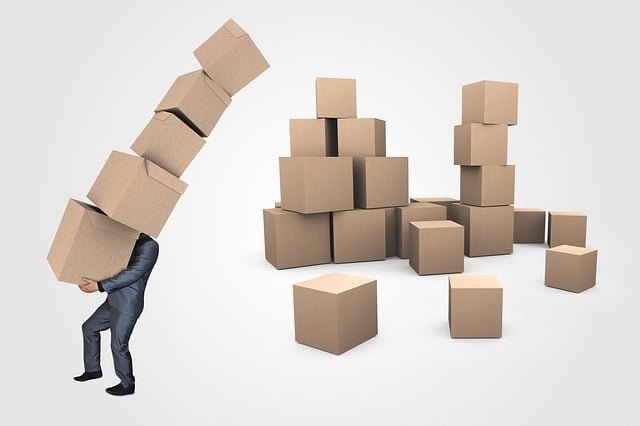
Moving boxes help make packing more efficient and protect your items from damage during transit. So, you need to choose the right boxes while packing for your move. In this blog, the moving experts at Serenity Moving Services will share 11 different types of moving boxes to help you pack effectively.
Different Kinds Of Moving Boxes
Different rooms and items will require different types of moving boxes. If you want to protect your belongings and maximize space in your moving truck, it’s important to carefully select the right box for each type of item. Here are some of the options you can choose from.
Small Cardboard Boxes (12-14 inches)
To pack tiny, delicate, and fragile items, it’s best to choose small cardboard boxes that have proper insulation. Here are some examples of the items that a small cardboard box can accommodate:
- Mugs
- Perfume bottles
- Small electronic items
Medium Cardboard Boxes (14-18 Inches)
Medium cardboard boxes are useful for packing various items, from books to clothes and toys.
Large Cardboard Boxes (18-24 Inches)
Large cardboard boxes are usually for larger items or lighter items, such as clothing. Be careful what you put in large boxes, as they can get heavy quickly.
Banker Boxes
Banker boxes are 10 inches tall, 12 inches wide, and 15 inches deep. Banker boxes are mostly used to make organizing and storing documents easier. These boxes are manufactured from corrugated, durable, and lightweight cardboard. They include lids or flaps that can be folded and locked to facilitate stacking and keep the items safe from dust, moisture, and other hazards.
Custom Crates
It’s best to use custom-made crates for kitchenware and electronics. These moving boxes have dividers that keep electronic items or dishes from touching and protect them. Also, they have plenty of space for adding extra padding materials like shock-absorbing foam sheets or EPS (Expandable Polystyrene). The extra layer of protection ensures that your things will not be damaged during the move.
Dish and Glass Boxes
Dish and glass boxes are a great option because they are carefully made to keep fragile dishes and glasses safe during transport. Corrugated cardboard dividers keep items separate to prevent them from scratching or cracking.
Flat-Panel TV Boxes
Long, narrow cardboard boxes are used for electronic items like computer monitors and TVs. They can accommodate fragile items with packing foam and wrap around them to absorb shocks.
Insulated Foam Containers
Use insulated foam containers to pack and move fragile items like china dishes and electronics items. The insulation provides resistance to shocks that may occur during transit.
Lamp Boxes, Mirror Cartons, and Picture Boxes
For packing items like lamps, mirrors, and pictures, buy specialized boxes that are the right length and width. These specialty boxes provide insulation and shock resistance for fragile items.
Plastic Bins
For items that are going to be stored in your basement, garage, or attic, consider purchasing plastic bins. These bins are made of durable materials and come in a variety of sizes, colors, and styles. These bins can be stacked and clearly labeled to make storing and finding things easier.
Wardrobe Boxes
These special boxes are a unique way to keep clothes in good shape and make packing and unpacking easier. Since wardrobe boxes have a built-in hanging rod, you can easily move your clothes from your closet to your new home. This preserves your clothes wrinkle-free during the move and makes the transition to your new bedroom simpler.
How Many Boxes Do You Need?
To help you decide how many boxes you will need for moving, we have laid out four simple factors to consider:
Number Of Rooms
The first factor is the number and the type of rooms you have. Each room will need its own type of box. Kitchens, in particular, tend to require more boxes than most people realize.
Household Members
More people, more boxes. Make sure you have enough boxes for each person to keep their belongings separate.
Number Of Years Lived in The Home
Belongings tend to accumulate over time. The longer you have lived in one place, the more stuff may have accumulated in closets, attics, and basements.
Size Of The Home
The bigger the house, the more boxes you will need. Use a packing calculator that takes into account square footage to determine how many boxes you need.
Packing Calculator
A packing calculator is a tool that can help you estimate how many boxes to buy. Many packing calculators estimate the number of boxes you need using factors like the number of bedrooms in your home or the total square footage of your home.
Here is a rough estimate of the number of boxes that you might need based on the square footage of your home.
| Size of Your Home |
Small boxes (16”x16”x12”) |
Medium boxes
(18”x16”x18”) |
Large boxes
(18”x18”x24”) |
Extra large boxes (24”x18”x24”) |
| < 700 sq. feet | 10 | 9 | 5 | 2 |
| Up to 900 sq. feet | 15 | 13 | 7 | 3 |
| Up to 1,200 sq. feet | 22 | 20 | 10 | 6 |
| Up to 1,600 sq. feet | 32 | 30 | 15 | 10 |
| Up to 2,000 sq. feet | 40 | 35 | 20 | 13 |
| Up to 2,500 sq. feet | 45 | 40 | 25 | 16 |
Where To Get Moving Boxes?
You can buy moving boxes from lots of places; they are now widely accessible online and in hardware or department stores. You may also be able to get used boxes from stores that usually discard them or people who have moved already. Popular, standard-size moving boxes that have been used already are available through U-Haul Box Exchange, Craigslist, Freecycle Network, and Facebook marketplace. At Serenity Moving Services, we offer our customers packing supplies and customized packing materials, which can be ordered easily.
Determining What Size Moving Boxes You Need
If you under-fill your boxes, it will increase the cost of packing supplies, and your belongings will take up more space in the moving truck. Similarly, if you over-pack them, the risk of the boxes being too heavy increases.
Here is a chart summarizing standard box sizes, along with their weight capacity.
| Home Area | Small boxes
(16” x 16” x 12”) |
Medium boxes
(18” x 8” x 16”) |
Large boxes
(18” x 18”x 24”) |
Extra large boxes (22” x 22” x 22”) |
| Avg. capacity of Boxes | 1.5 cubic feet | 3.0 cubic feet | 4.5 cubic feet | 6.0 cubic feet |
| Est. weight range | 25 Kg | 29.5 Kg | 29.5 Kg | 29.5 Kg |
Furthermore, the following tips can help you determine what combination of box sizes you need.
Tip 1: Start by making a complete list of everything you own. Group things by type (like clothes, books, and kitchen supplies) to get an idea of how much space you need to pack.
Tip 2: Sort your things into groups based on which type of box you need. This will help you decide which box sizes or specialty boxes you need.
Tip 3: Estimate the volume of belongings in each group and determine how many boxes or specialty boxes you need.
Tip 4: Remember that fragile things need more care. Choose smaller boxes for fragile items so they have enough padding.
Picking the correct moving boxes is crucial for hassle-free relocation. While figuring out the number and sizes of boxes you might need for your move, take three factors into account – the fragility, size, and amount of goods. If you want professional advice, Serenity Moving Services is here to help! With 11+ years of experience and expertise in local moving, loading & unloading, piano moving, and gun-safe moving services, we also offer efficient and cost-effective packing services in Oklahoma to make your move easier and faster.





